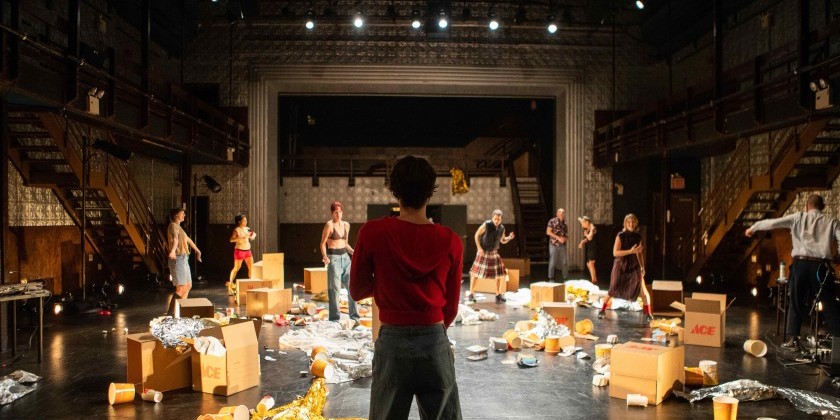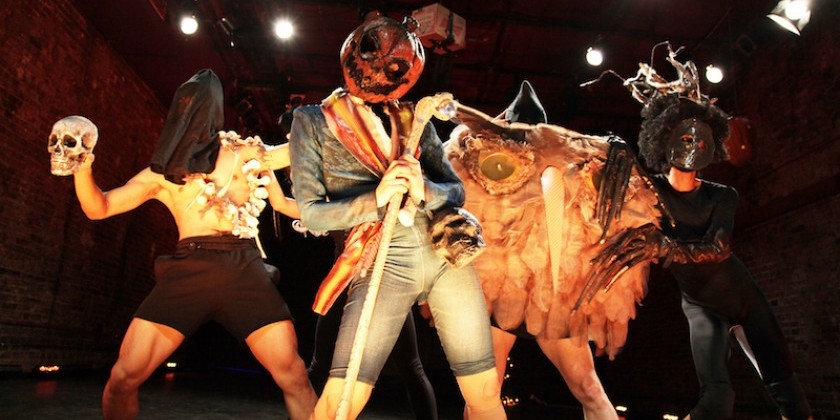IMPRESSIONS: Ashley Chen and Compagnie Kashyl at La MaMa Experimental Theatre Club

Choreographer: Ashley Chen
Lighting Designer: Eric Wurtz
Composer: Pierre Le Bourgeois/Animaux Vivants
Compagnie Kashyl Dancers: Magali Caillet-Gajan, Ashley Chen, Peggy Grelat-Dupont, Mai Ishiwata, Theo Le Bruman, Lucius Romeo-Fromm, Eric Wurtz
NYU Tisch School of the Arts Dancers: Brooke Biafore, Louis Coleman, Remy Corbin, Elena Wrinkle Garcia, Celeste Goldes, Salma Kiuhan, Jacqueline Lee, Lilly Lorber, Kaitlyn Posada, Ngozi Mokwunye, Emilia Pace, with graduates Camryn Tomaszewski and Salma Kiuhan
Special guest: Julian Monty
Filmmaker: Peter Steven
Special reimagined performance of choreographer Merce Cunningham’s Dime a Dance with former MCDC member, Cheryl Therrien, Anna Chirescu, and Ashley Chen
Compagnie Kashyl's performances received support from Villa Albertine as part of the Albertine Dance Season, French Institute and Normandy Region.
The French choreographer Ashley Chen brought five works: Unisson, Rush, and Distances, a triptych that questions social behavior; TUMBLE, which documents Chen's journey as an artist; and the film OutSide Flow, based on a choreography of laborer gestures to LaMaMa Experimental Theatre Club from November 30 to December 10. A special performance of Merce Cunningham’s Dime a Dance from 1953, not attended by this reviewer, was performed by former Merce Cunningham Dance Company member and Chen's partner, Cheryl Therrien, and Anna Chirescu, a dancer of MCDC repertory.
Common to all Chen’s episodic dances are speaking while moving, recorded and live music, and an abundance of running. On four different programs, the dances feature Chen’s Compagnie Kashyl, his boyhood friend, Julien Monty, and New York University undergraduate and newly graduated dancers.

The opening night performance of the sprawling 75-minute Unisson greets the audience with a magical and messy set of large cardboard boxes, paper cups, gold and silver crinkly warming blankets, and sheets of paper strewn across the floor. Partnerships, solos and groupings dissolve and reform both slowly and quickly, and with abandon and with definition. Noted were loose unison and circular phrases (the dancers studied numerous global social dances from which to develop movement), knees to chest while hopping, and nearly constant running around the stage’s perimeter. When crumpling from fatigue, the performers lean on one another in reliance. They call out numbers in French and English, and sing The Doors’ Waiting for the Sun off-key. This dizzying but beautiful spectacle, a social dance for current times, is accompanied by cellist, DJ, and composer Pierre Le Bourgeois and lighting designer, Eric Wurtz, visibly situated on either side of the stage. The cello squeals and groans. Lights bathe the stage in red.

Eight intergenerational performers lounge with insouciance or shimmy loosely, slap the floor, bounce, and step. The dancers, garbed in items of apparel including a red tartan and black vest, a Chanel-like sheath, red sneakers, jeans and black bra, stretch and squiggle. They stomp, lunge and balance, migrate downstage and spread. To low buzzing sounds, and tapping feet, a group builds a skyscraper of boxes, and a woman pulls a long, trailing plastic sheet around the perimeter of the space. Two women clasp hands, then cleave. The individual is tolerated and pulled into the group. Chen's Scottish, French and Chinese heritage influences his desire to celebrate individuality while forming community.
The dance resolves (after several false endings and too long by 30 minutes), when the dancers work together to organize the elements of the set. They carve a pathway of cups and stack the boxes to create sculpture. Once the center is free of detritus, each mumbles a different song while moving independently downstage.

“As a performer I like to jump on walls and roll on the floor,” notes Chen in an interview on November 28. As seen in Unisson, later in Distances, and indeed, too, in the 45-minute Rush, Chen and longtime friend and formidable dancer, Monty, sure can run. At 44 years, they run to the point of exhaustion, seemingly to outrun time, to outrun death. Clips of rock ‘n roll from the 1960s to 90s, from Blondie to the Breeders, DJ’d by Le Bourgeois, are piled insistently one on top of the next. The shared music was a means of communication in Chen’s and Monty’s teenage years.

Opening with the Rolling Stones, heard on three large speakers-as-set, the lusty sound bounces from one speaker to the next. As in the 80s, parts of the song stick and repeat like a needle on a vinyl record. The casually dressed performers face one another (one senses that they enjoy a casual yet fierce friendship). In slow motion they bend to the extreme, one forward, the other back as a segment of Wild Thing by The Doors, plays. Sneakers squeak as the dancers run past one another on the diagonal, spliced with bits of phrases that include rolls, a turn with a whipping leg, deep lunges and hops. After full out running, clapping hands as they pass one another, they collapse and experience brief respites. At the end of a long passage of walks, each on different counts, Chen wraps his arm around the neck of Monty.
Two in-process works, TUMBLE, a duet with the inventive cellist Le Bourgeois (this is the first draft of a longer work, Degringolade), and OutSide Flow created with Chen's filmmaker half brother, Peter Steven, though perhaps unresolved, are succinct, piquant, and full of mystery and pathos.

Chen, in TUMBLE, a splendid and accomplished dancer, carves etched phrases. Elegant, weighted and off-center, Chen rebounds from lofty tosses and folds to the floor. In lime green shirt and khaki pants, Chen, while dancing, recounts his life as a performer from youngster to his years with MCDC, and with other notable choreographers, as well as, his own life as a creator.

The number of liters of booze consumed (365 from 2013-19 while choreographing and performing whack) are noted as Chen bends forward. He illustrates his role as a pig at six years old by crawling on the floor and snorting. Wide lunges from Cunningham’s Pictures, and the delight in skipping and snapping fingers as a child ("It's good to dance around as if no one is looking," says Chen) and his signature running completes the work. The final calm, “Thank You," is spoken directly to the audience. Chen’s dancing is a highlight of the evening.
Outside flow War zone from Ashley Chen on Vimeo.
The film, OutSide Flow is based on laborer gestures that lend a staccato rhythm to the rough and compelling movement. Notable, too, is the scenery: abandoned graffitied buildings, busses, cars and machinery in a Californian desert, the fountain spraying NYU graduates in Washington Park, the shockingly clean New York City subway car, and a pier on long legs that extends into the ocean. Exploration of seemingly dangerous machinery by Chen, the rush of the ocean that could swallow the hooded young woman, and a similar scenario but on a subway car, is haunting. Each captivating scene builds to a complete vignette.

The faces of the all-female NYU cast plus Compagnie Kashyl women dancers are covered in Distances, to bring attention to the body and the body's unabashed desire to move in fantastic ways. Though less successful than the other dances, the committed performers reiterate Chen’s choreographic methods by singing songs such as Carol King's So Far Away and nursery rhymes while running, grouping, supporting, and abandoning. Several concurrent scenes, like a woman perched on the back of another lying face down on the floor, superimposed with other scenes, creates a prismatic, roiling impact.












